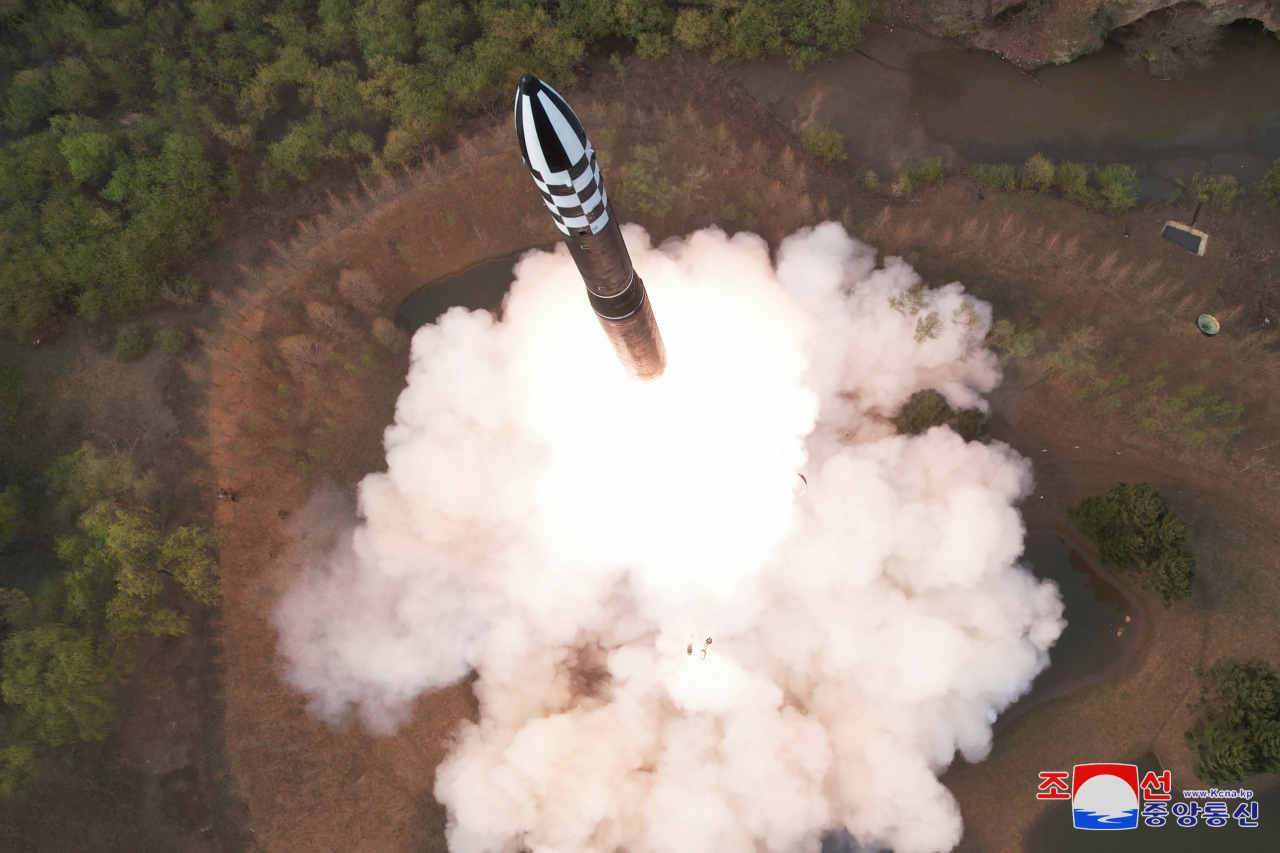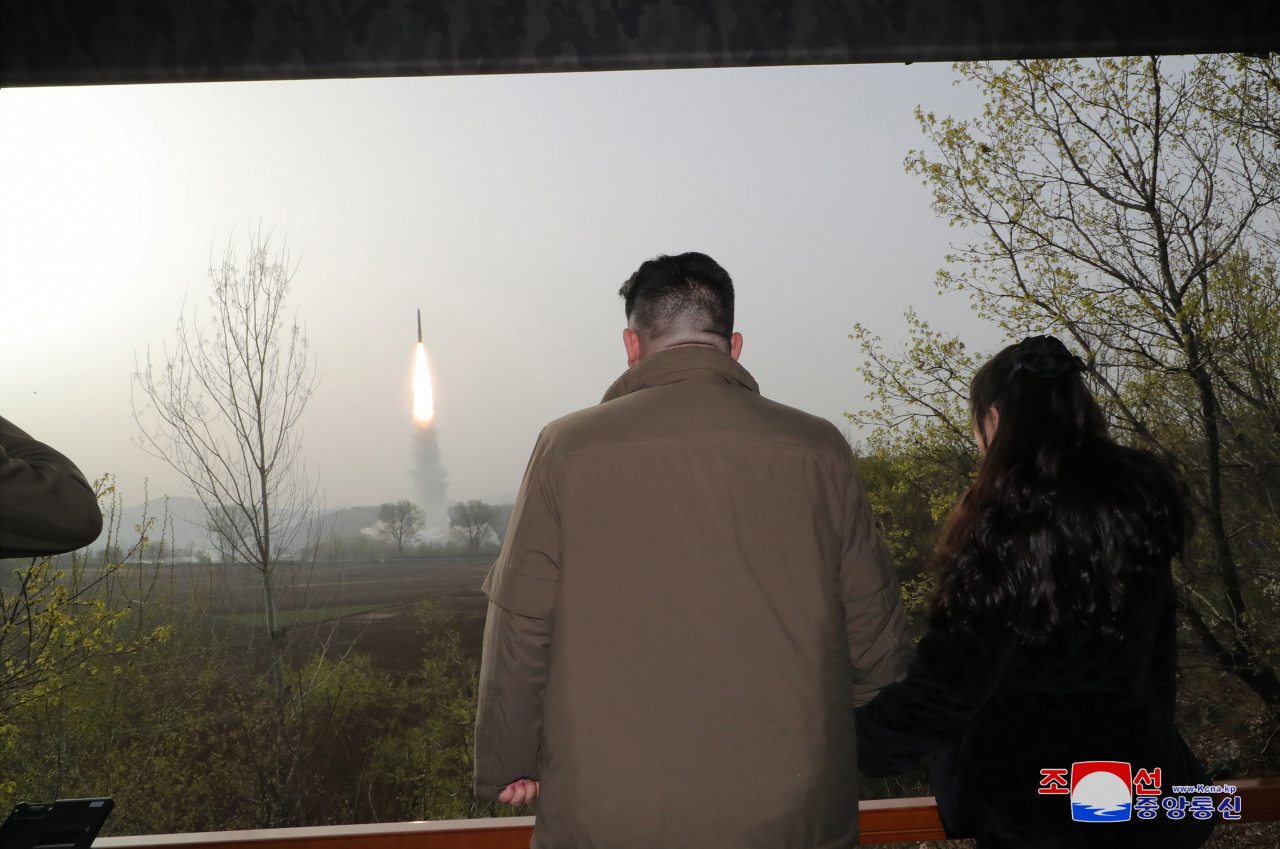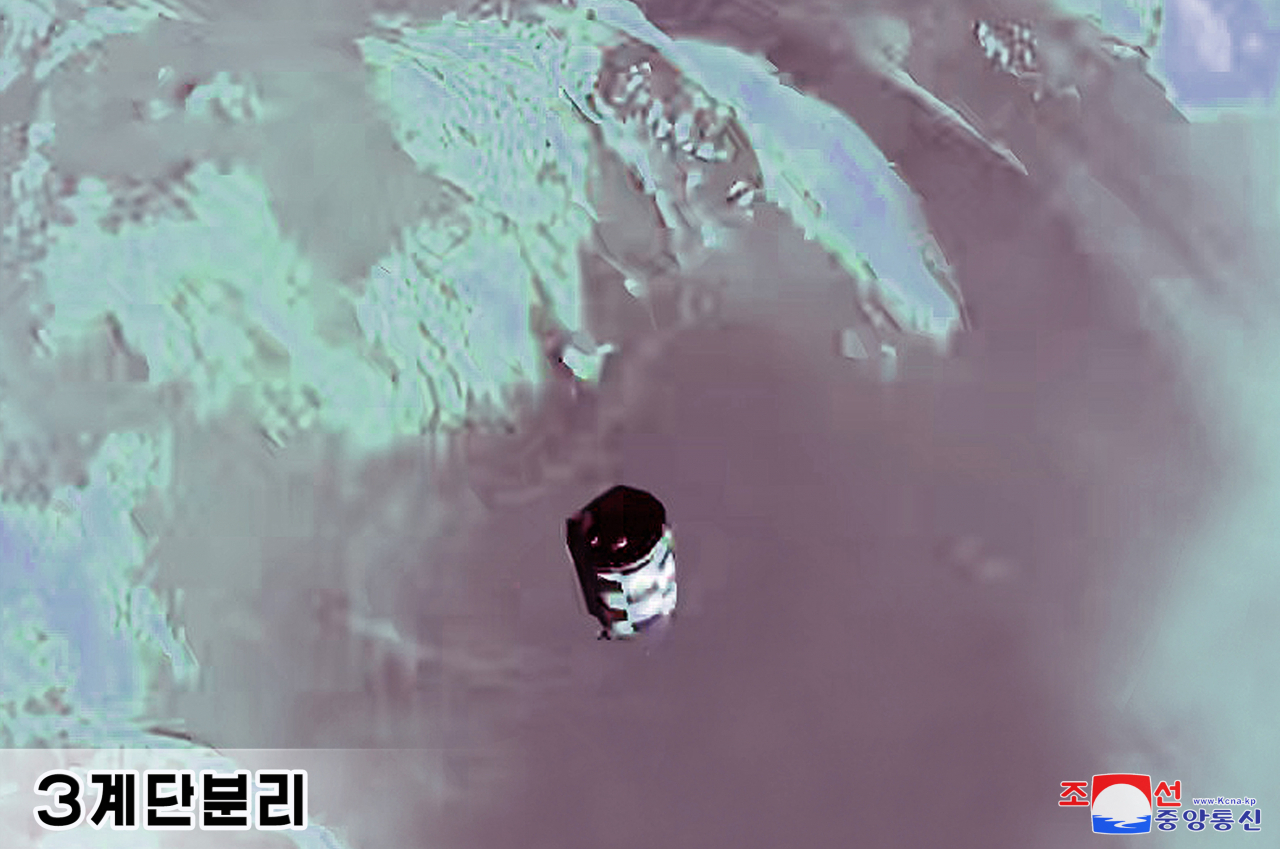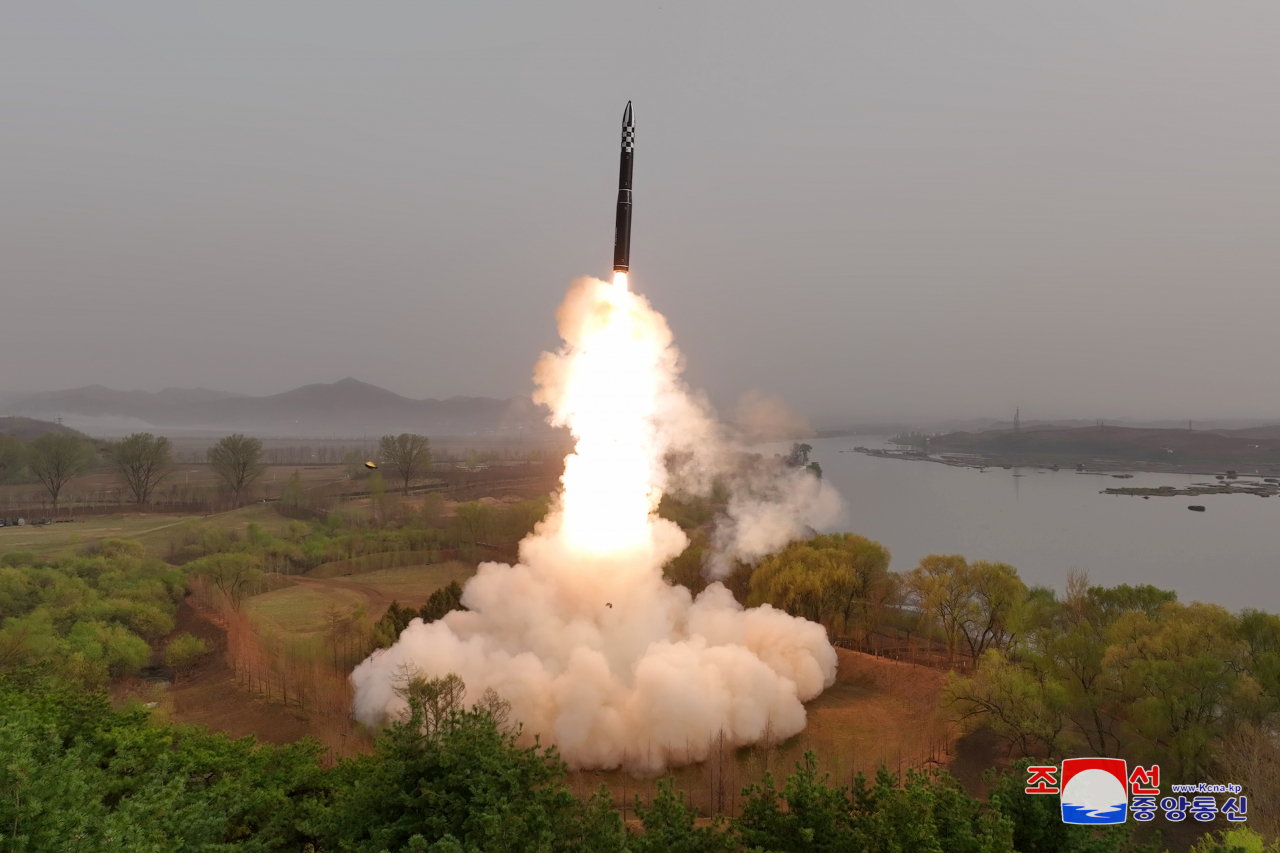 |
This photo, provided by North Korea's official Korean Central News Agency on Friday, shows the North's new solid-fuel Hwasong-18 intercontinental ballistic missile, test-fired the previous day under the guidance of North Korean leader Kim Jong-un. (Yonhap) |
North Korea claimed Friday that the country had successfully test-fired a new-type solid-fuel intercontinental ballistic missile for the first time on Thursday., under the guidance of the country’s leader Kim Jong-un. It labeled the ICBM as its “powerful, strategic attack means.” The South Korean military also confirmed that the test-launch aimed to develop a solid-propellant ICBM, although it assessed that North Korea still has a long way to go to complete the weapon development.
North Korean state media touted that the new Hwasong-18 ICBM will “fulfill its mission of significant war deterrence as a prospective main force of the DPRK,” in a Korean-language dispatch, referring to North Korea's official name, the Democratic People’s Republic of Korea.
“The development of the new-type intercontinental ballistic missile Hwasongpho-18 will significantly reorganize the components of our strategic deterrence, rapidly advance the effectiveness of our nuclear counterattack posture and transform the practicality of our offensive military strategy,” Kim Jong-un was quoted as saying. “Pho” in the ICBM’s name means “artillery” in Korean.
 |
This photo, provided by North Korea's official Korean Central News Agency on April 14, 2023, shows North Korean leader Kim Jong-un and his daughter Ju-ae observing the test-firing of the North's new solid-fuel Hwasong-18 intercontinental ballistic missile the previous day. (Yonhap) |
The first test-firing of the Hwasong-18 ICBM aimed to “confirm the performance of high-thrust solid-fuel engines for multistage missiles and the reliability of stage separation technologies and control systems with different functions as well to estimate military effectiveness of the new strategic weapon system.”
The first stage of the Hwasong-18 ICBM flew at a normal angle, and the second and third stages flew at a lofted trajectory in light of the safety of neighboring countries and of the safety of stage separation during intraterritorial flight, North Korean state media said, adding that it had limited the maximum speed of the ICBM.
North Korea state media said the first stage had landed in waters 10 kilometers off the Hodo Peninsula in South Hamgyong Province and the second stage in waters 335 kilometers east of Orang County, North Hamgyong Province. But state media did not report whether the final stage had fallen.
“The test launch has provided guarantee and credibility that the new-type intercontinental ballistic missile would become a powerful, strategic attack means with greater military effectiveness,” state media said, adding that essential components of the missiles met performance requirements.
“The Hwasongpho-18 weapon system — which will be equipped with and operated by the DPRK strategic force in accordance with the long-term plan for building the state nuclear force — will perform its important mission and duty as the most powerful, pivotal and principal means in defending the DPRK, deterring aggression and defending the national security.”
 |
North Korea's new solid-fuel Hwasong-18 intercontinental ballistic missile is loaded on a transporter erector launcher during the launch of the missile, overseen by the North's leader Kim Jong-un, near Pyongyang on April 13, 2023, This photo, provided by North Korea's official Korean Central News Agency the following day. (Yonhap) |
South Korea’s Defense Ministry said Friday that the test launch of the Hwasong-18 was an “intermediate test to develop a solid-propellant long-range ballistic missile,” underscoring that “additional time and efforts are required to complete the development of the system.”
The confirmation came one day after the South Korean military shared the initial assessment that Pyongyang might conduct its first test launch of the solid-fuel ICBM displayed at a military parade in February in the run-up to the April 15 anniversary of the birth of the country’s late founder, Kim Il-sung.
The South Korean military said North Korea fired the intermediate- or long-range ballistic missile into waters off its east coast from an area on the outskirts of the capital city of Pyongyang at 7:23 a.m. on Thursday. The missile traveled around 1,000 kilometers for more than 30 minutes and flew at an altitude of below 3,000 km, a military source confirmed to The Korea Herald.
“In a nutshell, the test launch mainly intended to verify the performance of the first stage-one solid propellant rocket motor,” said Chang Young-keun, a professor at Korea Aerospace University. “Therefore, it is expected that North Korea will conduct a test launch with a lofted trajectory in the foreseeable future.”
Chang said North Korea would seek to demonstrate the capabilities of a solid propellant rocket motor that can fly the Hwasong-18 ICBM more than 10,000 kilometers.
The first test launch came four months after North Korea tested what appears to have been a new model of a new solid-fuel rocket engine at the Sohae Satellite Launching Station in December 2022. The test of what North Korea labeled as the first-ever static firing testing of a “high-thrust solid-fuel motor with a thrust of 140 ton-force” was aimed at developing a new solid-fuel ICBM. North Korean leader Kim Jong-un said he expected to see “another new-type strategic weapon within the shortest period of time” while guiding the testing.
Then, North Korea displayed the Hwasong-18 ICBM at a military parade in February this year.
 |
This photo released by the North's official Korean Central News Agency on April 14, 2023, shows the third stage separation of the Hwasong-18 intercontinental ballistic missile during its test launch the previous day. (Yonhap) |
North Korea could conduct another test of the Hwasong-18 ICBM on the occasion of the Foundation Day of the Korean People’s Revolutionary Army, which falls on April 25, or the upcoming South Korea-US summit on April 26, said Hong Min, director of the North Korean Research Division at the government-funded Korea Institute for National Unification.
“North Korea calibrated the timing of the latest test launch to concurrently demonstrate achievements required to celebrate the Day of the Sun and prove its fulfillment in developing the strategic weapon as announced (by Kim Jong-un),” Hong said.
The test launch came as North Korea gears up to celebrate the 111th anniversary of the late founder Kim Il-sung’s birth, celebrated as the Day of the Sun holiday which falls on April 15.
Hong said the Hwasong-18 test launch Thursday was also intended to show North Korea’s tit-for-tat military response against combined military exercises between South Korea and the US in March and April and show off its deterrence against the US prior to the South Korea-US summit.
 |
This photo, provided by North Korea's official Korean Central News Agency on Friday, shows the North's new solid-fuel Hwasong-18 intercontinental ballistic missile, test-fired the previous day under the guidance of North Korean leader Kim Jong-un. (Yonhap) |
Experts also pointed out that North Korea used a cold-launch method – in which a missile is exploded by gas produced by a gas generator and a rocket engine ignites after the missile clears the silo – to launch the Hwasong-18. The cold-launch system has advantages in ejecting missiles more safely even if a missile engine malfunctions at launch, as compared to the hot-launch method.
“In particular, North Korea seems to seek to neutralize the South Korean military’s kill chain capabilities given that the country hid the missile in a nearby tunnel, abruptly transported the missile, and swiftly launched the missile using the cold-launch method,” said Yang Uk, a research fellow at the Asan Institute for Policy Studies think tank.
The Kill Chain preemptive strike mechanism is the first axis of the three-pronged defense system that the South Korean military has sought to build to counter escalating missile and nuclear threats from North Korea.
Hong said North Korea has sought to maximize the effectiveness in operating ICBMs by simultaneously utilizing solid-propellent engines, cold-launch methods and transporter erector launchers, which are mobile launchers used for transporting and launching missiles.
Solid-fuel missiles have advantages over liquid-fueled missiles in that they can be fueled during their manufacturing process. They can also be launched on short notice, and therefore have greater mobility and survivability.
But the Defense Ministry brushed off concerns over the South Korean military’s preemptive strike capabilities.
“Our military has capabilities to detect, strike and defend against North Korean missile threats to the Korean Peninsula,” the ministry said in a statement.
The ministry underscored that the South Korean military has developed and evolved its three-axis defense system and related key capabilities and technologies in light of escalating North Korean threats, citing ultraprecision, prompt strike capabilities and development of high-power ballistic missiles as examples.







![[Today’s K-pop] Blackpink’s Jennie, Lisa invited to Coachella as solo acts](http://res.heraldm.com/phpwas/restmb_idxmake.php?idx=644&simg=/content/image/2024/11/21/20241121050099_0.jpg)